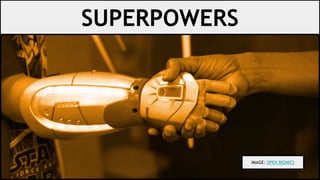Superpowers - Empowering Narrative Making in Others
- 2. 6TH GRADE... 2 DAYS... 3 HOURS/day... ALL MATERIALS & IDEAS WELCOME DESIGNING SUPERHEROES! IMAGE: IBTIMES
- 3. DISABILITIES SUPER ABILITIES! IMAGE: CBS NEWS CCSS.Math CCSS.ELA NGSS
- 4. IMAGE BY ADAM FOSTER DIY PHYSICAL COMPUTING DESIGN THINKING HCD INTRO TO: Care-based Learning Constructionism Embodied Cognition Goal-based Scenarios Narrative Intelligence
- 5. INSPIRED BY AIMEE MULLINS... IMAGE: TED ItŌĆÖs not fair having 12 pairs of legs!
- 6. IMAGE: TED A narrative models not only a world but the minds seeking to give it its meanings. AND JEROME BRUNER... SOURCE: BRUNER, 2002, p. 27
- 7. IMAGE: WIKIPEDIA The diversity of outcomes is an indicator of success. AND MITCHEL RESNICK! SOURCE: RESNICK & SILVERMAN, 2005, p. 118
- 8. DAY 1 DAY 2 1. Introduction & Overview: presentation of the topic and of some examples of people that have superpowers or super-abilities. 2. Collective Oral Brainstorm: facilitator instigates students to think about other superpowers and super-abilities that can come with what is usually referred to as a disability. 3. Group Ideation: Facilitator gives students ŌĆ£personaŌĆØ sheets, presenting individuals with specific conditions, whom students are turning to superheroes. 4. Storyboarding: groups select some of their best, most incredible ideas and start to storyboard a superhero character in the comics format. 5. Lo-Fi Prototyping: students use varied materials to give physical appearance to the super-abilities and superheroes they created. Prototype at this stage is non-functional. Facilitators help them. 6. Introduction to Makey Makey & Scratch: students see concrete examples of Makey Makey and Scratch projects. The idea is to make them realize how much they can build by themselves through these simple kits. 7. Functional Prototyping: students, helped by facilitators, begin to add electricity, movement and action to what they created and prototyped. 8. Presentation: post-mortem and presentation. People with disabilities in the audience.
- 9. SAMPLE RESULT THE PIANO-ARM! FOR PROSTHETIC HAND-USERS CHECK THE VIDEO!
- 11. ŌĆ” AND SKETCHING, OF COURSE! STORYBOARDING...
- 14. PIANO TOOLS
- 15. Bruner, J. S. (2002). Making stories: Law, literature, life. New York: Farrar, Straus, and Giroux. Resnick, M., & Silverman, B. (2005). Some reflections on designing construction kits for kids. In Proceedings of the 2005 conference on Interaction design and children (pp. 117-122). ACM. REFERENCES IMAGE: SRI LESTARI















